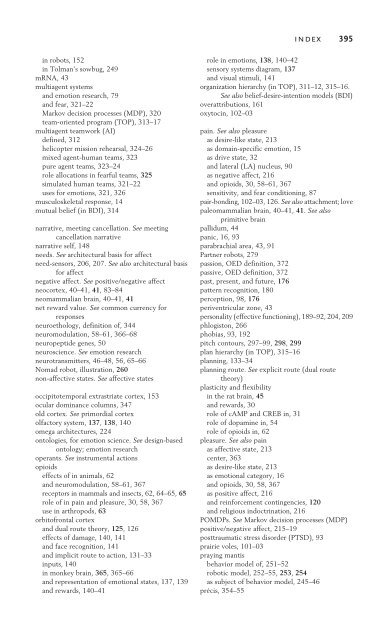Who Needs Emotions? The Brain Meets the Robot
Who Needs Emotions? The Brain Meets the Robot
Who Needs Emotions? The Brain Meets the Robot
Create successful ePaper yourself
Turn your PDF publications into a flip-book with our unique Google optimized e-Paper software.
in robots, 152<br />
in Tolman’s sowbug, 249<br />
mRNA, 43<br />
multiagent systems<br />
and emotion research, 79<br />
and fear, 321–22<br />
Markov decision processes (MDP), 320<br />
team-oriented program (TOP), 313–17<br />
multiagent teamwork (AI)<br />
defined, 312<br />
helicopter mission rehearsal, 324–26<br />
mixed agent-human teams, 323<br />
pure agent teams, 323–24<br />
role allocations in fearful teams, 325<br />
simulated human teams, 321–22<br />
uses for emotions, 321, 326<br />
musculoskeletal response, 14<br />
mutual belief (in BDI), 314<br />
narrative, meeting cancellation. See meeting<br />
cancellation narrative<br />
narrative self, 148<br />
needs. See architectural basis for affect<br />
need-sensors, 206, 207. See also architectural basis<br />
for affect<br />
negative affect. See positive/negative affect<br />
neocortex, 40–41, 41, 83–84<br />
neomammalian brain, 40–41, 41<br />
net reward value. See common currency for<br />
responses<br />
neuroethology, definition of, 344<br />
neuromodulation, 58–61, 366–68<br />
neuropeptide genes, 50<br />
neuroscience. See emotion research<br />
neurotransmitters, 46–48, 56, 65–66<br />
Nomad robot, illustration, 260<br />
non-affective states. See affective states<br />
occipitotemporal extrastriate cortex, 153<br />
ocular dominance columns, 347<br />
old cortex. See primordial cortex<br />
olfactory system, 137, 138, 140<br />
omega architectures, 224<br />
ontologies, for emotion science. See design-based<br />
ontology; emotion research<br />
operants. See instrumental actions<br />
opioids<br />
effects of in animals, 62<br />
and neuromodulation, 58–61, 367<br />
receptors in mammals and insects, 62, 64–65, 65<br />
role of in pain and pleasure, 30, 58, 367<br />
use in arthropods, 63<br />
orbitofrontal cortex<br />
and dual route <strong>the</strong>ory, 125, 126<br />
effects of damage, 140, 141<br />
and face recognition, 141<br />
and implicit route to action, 131–33<br />
inputs, 140<br />
in monkey brain, 365, 365–66<br />
and representation of emotional states, 137, 139<br />
and rewards, 140–41<br />
index 395<br />
role in emotions, 138, 140–42<br />
sensory systems diagram, 137<br />
and visual stimuli, 141<br />
organization hierarchy (in TOP), 311–12, 315–16.<br />
See also belief-desire-intention models (BDI)<br />
overattributions, 161<br />
oxytocin, 102–03<br />
pain. See also pleasure<br />
as desire-like state, 213<br />
as domain-specific emotion, 15<br />
as drive state, 32<br />
and lateral (LA) nucleus, 90<br />
as negative affect, 216<br />
and opioids, 30, 58–61, 367<br />
sensitivity, and fear conditioning, 87<br />
pair-bonding, 102–03, 126. See also attachment; love<br />
paleomammalian brain, 40–41, 41. See also<br />
primitive brain<br />
pallidum, 44<br />
panic, 16, 93<br />
parabrachial area, 43, 91<br />
Partner robots, 279<br />
passion, OED definition, 372<br />
passive, OED definition, 372<br />
past, present, and future, 176<br />
pattern recognition, 180<br />
perception, 98, 176<br />
periventricular zone, 43<br />
personality (effective functioning), 189–92, 204, 209<br />
phlogiston, 266<br />
phobias, 93, 192<br />
pitch contours, 297–99, 298, 299<br />
plan hierarchy (in TOP), 315–16<br />
planning, 133–34<br />
planning route. See explicit route (dual route<br />
<strong>the</strong>ory)<br />
plasticity and flexibility<br />
in <strong>the</strong> rat brain, 45<br />
and rewards, 30<br />
role of cAMP and CREB in, 31<br />
role of dopamine in, 54<br />
role of opioids in, 62<br />
pleasure. See also pain<br />
as affective state, 213<br />
center, 363<br />
as desire-like state, 213<br />
as emotional category, 16<br />
and opioids, 30, 58, 367<br />
as positive affect, 216<br />
and reinforcement contingencies, 120<br />
and religious indoctrination, 216<br />
POMDPs. See Markov decision processes (MDP)<br />
positive/negative affect, 215–19<br />
posttraumatic stress disorder (PTSD), 93<br />
prairie voles, 101–03<br />
praying mantis<br />
behavior model of, 251–52<br />
robotic model, 252–55, 253, 254<br />
as subject of behavior model, 245–46<br />
précis, 354–55






